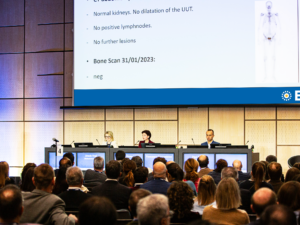The Uropathology Symposium (ESUP) delivered the latest updates on the WHO classification of genito-urinary tract tumours for 2022, and the significant role that histopathology plays in the selection of treatment for cancer patients. Taking place on day one of EMUC22 in Budapest, the symposium was co-chaired by Prof. Maurizio Colecchia (IT) and Prof. Rodolfo Montironi (IT).
In her lecture “The new WHO classification of renal tumours”, Pathologist Dr. Maria Rosaria Raspollini (IT) shared an update on the 2022 classification changes, addressing the concept of molecularly defined renal tumour entities in particular. According to Dr. Raspollini, traditionally, renal tumour subtypes have been named on the basis of predominant cytoplasmic features (clear cells/pink cells RCC) and chromophobe RCC. Now there are renal tumour subtypes named on the basis of architectural features (papillae RCC).
Dr. Raspollini stated: “Clear cell RCC account for 60-75% of all RCC’s and are characterised by neoplastic cells with predominantly clear and occasionally eosinophilic cytoplasm, accompanied by an abundant network of blood vessels and associated with biallelic VHL inactivation. Chromophobe RCC accounts for 5-7% of cases and are characterised by large pale and/or smaller eosinophilic tumour cells with wrinkled nuclei and perinuclear haloes. The WHO 2022 papillary RCC is characterised by papillary and tubular structures lined by cuboidal cells with scant or lightly basophilic cytoplasm with an overall basophilic appearance. Foamy histiocytes and psammoma bodies may also be present.”
On the topic of new renal tumour entities, Dr. Raspollini stated that clear cell papillary renal cell carcinoma has been reclassified as clear papillary renal cell tumour, because there is not a described metastatic event. “These tumours are mainly pT1 well-circumscribed, encapsulated and cystic change can occur. Specific molecular pathological features that it lacked were chromosome 3p loss and alterations of VHL, as well as mutations in TSC1, TSC2, MTOR or ELOC (TCBE1).”
According to Dr. Raspollini, another new entity is Eosinophilic solid and cystic renal cell carcinoma (ESC-RCC). “These are typically well-circumscribed, tan, solid and cystic, with reported sizes ranging from <10 to 135mm. ESC-RCC is characterised by solid and cystic architecture, eosinophilic cytoplasm and coarsely granular, basophilic cytoplasmic stippling. The majority of ESC-RCC’s appear to have been cured by resection. Rare cases with metastases have been reported.”
Morphological and molecular reporting strategy
During his lecture “The new WHO classification of bladder tumours – why the morphology is important in the molecular age”, Prof. Antonio Lopez-Beltran (PT) shared details on non-invasive urothelial neoplasms, points of practice and novelties, including urothelial papilloma and inverted urothelial papilloma.
“The classification papillary urothelial hyperplasia has disappeared” stated Prof. Lopez-Beltran. “We should report cases even if the WHO does not recognise it”.
Prof. Lopez-Beltran questions the correctness of the newly classified urothelial carcinoma “subtypes”, which were previously “variants”. The term “variant” has been exclusively reserved for genomic alternations. In his opinion, they are genetic variations.
Looking at what lies ahead in the future, Prof. Lopez-Beltran voiced the proposal of a combined morphological and molecular reporting strategy. “This is an evolving process from WHO in 1973 to WHO 2002/2016 to molecular subtyping using immunohistochemistry. Advantages of combined reports include providing the clinician with more information sooner, leading ultimately to a more personalised approach to current therapies.”
Prof. Lopez-Beltran ended his lecture with the comment “classifications are getting more difficult and more complicated, but we need to tell clinicians that we are going forward. We are driving towards a new time for pathology”.





